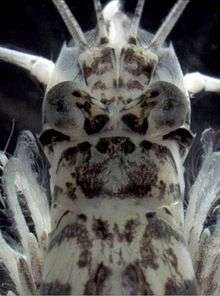Paramysis
Paramysis (from the Greek affix para-, "near", "beside", and the genus name Mysis) is a genus of mysid crustaceans (Mysidacea) in family Mysidae, distributed in coastal zone of low boreal East Atlantic Ocean, Mediterranean Sea and the basins of Black Sea, Sea of Azov and Caspian Sea (Ponto-Caspian Basin).
| Paramysis | |
|---|---|
 | |
| Head of Paramysis ullskyi | |
| Scientific classification | |
| Kingdom: | |
| Phylum: | |
| Subphylum: | |
| Class: | |
| Order: | |
| Family: | |
| Subfamily: | Mysinae |
| Tribe: | Mysini |
| Genus: | Paramysis Czerniavsky, 1882 |
Biogeography
The majority of Paramysis species are brackish- or freshwater endemics of the Ponto-Caspian Basin; some of them naturally spread more than 500 kilometres (310 mi) up large rivers, including the Volga, Don, Dnieper and Danube. A number of Ponto-Caspian species have been introduced outside the native range. Marine species from the Atlantic Ocean and Mediterranean Sea have probably descended from ancient Ponto-Caspian populations.[1]
Diversity
There are 24 species[2][3][4] classified into 7 subgenera.[3][5][6][7] Body length ranges from 1 to 4 centimetres (0.4 to 1.6 in). The largest species, like P. eurylepis, P. inflata, are found only in the Caspian Sea. Generic characters: subrostral plate; large eyes on short stalk; antennal scale with smooth outer margin, ended by strong spine, and distal segment rudimentary with five setae; four segments of pereiopod 1–4 carpopropodus; five segments in pleopod 4 of male.[3] Consumed by fishes; particularly important for juvenile sturgeons and zander.[5]
Two extinct species, previously included into this genus,[8][9] have been recently moved into extinct genus Sarmysis.[10]
Species
- Subgenus Paramysis sensu stricto
- Paramysis baeri Czerniavsky, 1882
- Paramysis bakuensis G. O. Sars, 1895
- Paramysis eurylepis G. O. Sars, 1907
- Paramysis kessleri (Grimm in G. O. Sars, 1895)
- Subgenus Metamysis G. O. Sars, 1893
- Paramysis grimmi (G. O. Sars, 1895)
- Paramysis inflata (G. O. Sars, 1907)
- Paramysis ullskyi Czerniavsky, 1882
- Subgenus Serrapalpisis Daneliya, 2004
- Paramysis incerta G. O. Sars, 1895
- Paramysis kosswigi Băcescu, 1948
- Paramysis lacustris (Czerniavsky, 1882)
- Paramysis sowinskii Daneliya, 2002
- Subgenus Mesomysis Czerniavsky, 1882
- Paramysis intermedia (Czerniavsky, 1882)
- Subgenus Nanoparamysis Daneliya, 2004
- Paramysis loxolepis (G. O. Sars, 1895)
- Subgenus Longidentia Daneliya, 2004
- Paramysis adriatica Wittmann, Ariani et Daneliya, 2016
- Paramysis helleri (G. O. Sars, 1877)
- Paramysis kroyeri (Czerniavsky, 1882)
- Paramysis nouveli (Labat, 1953)
- Paramysis agigensis Băcescu, 1940
- Subgenus Pseudoparamysis Băcescu, 1940
- Paramysis bacescoi Labat, 1953
- Paramysis pontica (Băcescu, 1940)
- Paramysis festae Colosi, 1922
- Paramysis portzicensis Nouvel, 1950
- Paramysis proconnesia Colosi, 1922
- Paramysis arenosa (G. O. Sars, 1877)
References
- Asta Audzijonyte; Mikhail E. Daneliya; Nikolai Mugue; Risto Väinölä (2008). "Phylogeny of Paramysis (Crustacea: Mysida) and the origin of Ponto-Caspian endemic diversity: Resolving power from nuclear protein-coding genes" (PDF). Molecular Phylogenetics and Evolution. 46 (2): 738–759. doi:10.1016/j.ympev.2007.11.009. PMID 18187346.
- R. Labat (1953). "Paramysis nouveli n. sp. et Paramysis bacescoi n. sp. deux espéces de Mysidacés confondues, jusqu'à présent, avec Paramysis helleri (G. O. Sars, 1877)". Bulletin of the Institute of Oceanography, Monaco. 1034 (5): 1–24.
- M. E. Daneliya (2004). "K sistematike mizid roda Paramysis (Crustacea, Mysidacea) iz basseina Ponto-Kaspiya". Zoologicheskii Zhurnal. 83: 408–416.
- M. E. Daneliya, A. Audzijonyte & R. Väinölä (2007). "Diversity within the Ponto-Caspian Paramysis baeri Czerniavsky sensu lato revisited: P. bakuensis G. O. Sars restored (Crustacea: Mysida: Mysidae)" (PDF). Zootaxa. 1632: 21–36. doi:10.11646/zootaxa.1632.1.2.
- A. N. Derzhavin (1939). Mizidy Kaspiya. Baku, Azerbaijan: Izdatelstvo AzFAN.
- M. Băcescu (1940). "Les Mysidacés des eaux roumaines (étude taxonomique, morphologique, bio-géographique et biologique)". Extrait des Annales Scientifiques de l'Université de Jassy. 26 (2): 453–804.
- K.J. Wittmann, A.P. Ariani, M. Daneliya (2016). "The Mysidae (Crustacea: Peracarida: Mysida) in fresh and oligohaline waters of the Mediterranean. Taxonomy, biogeography, and bioinvasion". Zootaxa. 4142 (1): 1–70. doi:10.11646/zootaxa.4142.1.1.CS1 maint: multiple names: authors list (link)
- G. Voicu (1974). "Identification des Myside's fossiles dans les depots du Miocène supérieur de la Paratéthys Centrale et Orientale et leur importance paléontologique, stratigraphique et paléogéographique". Geol. Carpath. 25: 23l–239.
- G. Voicu (1981). "Upper Miocene and Recent mysid statoliths in Central and Eastern Paratethys". Micropaleontology. 27 (3): 227–247. doi:10.2307/1485236. JSTOR 1485236.
- I. Petrescu; K. Wittmann (2009). "Catalogue of the Mysida type collection (Crustacea: Peracarida) from the "Grigore Antipa" National Museum of Natural History (Bucuresti)". Travaux du Muséum National d'Histoire Naturelle "Grigore Antipa". 52: 53–72.